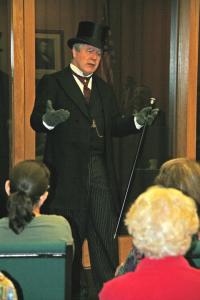A Brief Excerpt From Walter's Victorian Etiquette Presentation
Any proper discussion of Victorian etiquette needs to acknowledge that the topic is one of infinite complexity. It is certainly a lot more involved than memorizing which fork to use with the shrimp. People's social background, religious beliefs, ethnic heritage, geography, profession, and wealth all played their part in shaping public behavior.

I will try to touch a little bit on some of these influences, but I fear it will be possible to only brush quickly over them. In most cases, I will try to identify the universal attributes, shared by all groups, though I will also plunge into a certain amount of detail in some specific areas.
Before I continue, I should clarify: what do I mean by "Victorian"? The word refers to the period of the reign of Queen Victoria of England, from 1837 to 1901. It is also a word much abused by antique dealers and purveyors of lace encrusted kitch. I use the term when referring to the United States primarily because we Americans have never found a uniquely American term which encompasses as much as succinctly as Victorian. Therefore, I will use the term, without apology, even though Victoria was never our Queen.
I will start out with a few basic tenets.
First, ninety percent of everything you find in a Victorian etiquette manual or discussed in the writings of Victorians is nothing more than common courtesy, and would not seem at all out of place today. I am speaking of things along the lines of "Don't chew with your mouth open", or "Don't interrupt someone when they're talking" or "Try not to be a lot of bother when you are a houseguest". Nelson's first law of Victorian etiquette is "If it would be rude now, it was rude then". I won't waste a lot of time on the obvious, common sense varieties of good manners. If you want to act like a well mannered Victorian, act like a well mannered modern and you will be most of the way there.
Second, I want to avoid the trap of asserting that behaving in a manner other than that recommended by a Victorian etiquette manual is historically incorrect. These manuals spend a lot of time disparaging the behavior of the boorish, so one must therefore assume that the Victorian world was populated with a fair smattering of boorish people. Furthermore, a large proportion, if not a considerable majority of 19th Century Americans had no use for the elaborate rituals spelled out in etiquette books, but got by with common courtesy and country manners.
Third, this is not a workshop dedicated to showing how weird or quaint the Victorians were. I will not, for instance, waste time on nonsense like "the language of the fan", though I will be happy to tell you why I think it is nonsense at the end of the program.
Finally, I would like to cover the entire spectrum of Victorian society in this review, and not just focus on the elite 10 percent or so who had the leisure and financial resources to live up to all the requirements of a Victorian etiquette book. Victorian polite behavior was a continuum, with certain fundamental principles applying to all classes and conditions. The well to do might invent elaborate embellishments to these fundamentals, but they applied in their basic essence to almost everyone. Any 19th Century American, be he or she a banker, a bricklayer or housewife or a prostitute had a concept of a good Christian (or Jewish, or Agnostic or whatever) upbringing, and tried to impart some degree of good manners to their children, even if they were not of the top hat and bustle skirt persuasion
